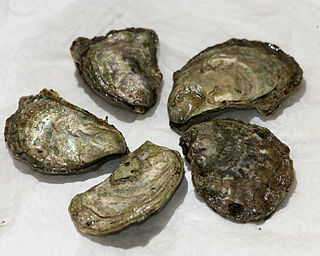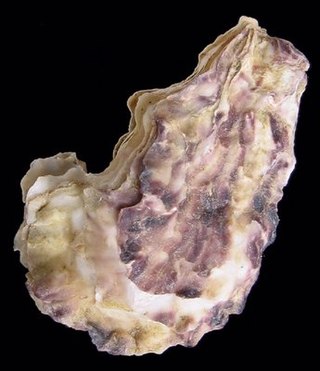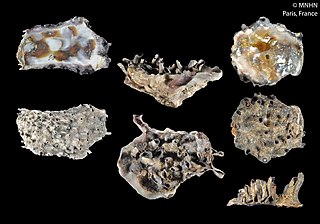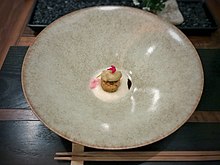
A pearl is a hard, glistening object produced within the soft tissue of a living shelled mollusk or another animal, such as fossil conulariids. Just like the shell of a mollusk, a pearl is composed of calcium carbonate in minute crystalline form, which has deposited in concentric layers. The ideal pearl is perfectly round and smooth, but many other shapes, known as baroque pearls, can occur. The finest quality of natural pearls have been highly valued as gemstones and objects of beauty for many centuries. Because of this, pearl has become a metaphor for something rare, fine, admirable and valuable.

Clam is a common name for several kinds of bivalve molluscs. The word is often applied only to those that are edible and live as infauna, spending most of their lives halfway buried in the sand of the seafloor or riverbeds. Clams have two shells of equal size connected by two adductor muscles and have a powerful burrowing foot. They live in both freshwater and marine environments; in salt water they prefer to burrow down into the mud and the turbidity of the water required varies with species and location; the greatest diversity of these is in North America.

Oyster is the common name for a number of different families of salt-water bivalve molluscs that live in marine or brackish habitats. In some species, the valves are highly calcified, and many are somewhat irregular in shape. Many, but not all oysters, are in the superfamily Ostreoidea.

Bivalvia, in previous centuries referred to as the Lamellibranchiata and Pelecypoda, is a class of marine and freshwater molluscs that have laterally compressed bodies enclosed by a shell consisting of two hinged parts. As a group, bivalves have no head and they lack some usual molluscan organs, like the radula and the odontophore. The class includes the clams, oysters, cockles, mussels, scallops, and numerous other families that live in saltwater, as well as a number of families that live in freshwater. The majority are filter feeders. The gills have evolved into ctenidia, specialised organs for feeding and breathing. Most bivalves bury themselves in sediment, where they are relatively safe from predation. Others lie on the sea floor or attach themselves to rocks or other hard surfaces. Some bivalves, such as the scallops and file shells, can swim. Shipworms bore into wood, clay, or stone and live inside these substances.

Crassostrea is a genus of true oysters containing some of the most important oysters used for food.

The Ostreidae, the true oysters, include most species of molluscs commonly consumed as oysters. Pearl oysters are not true oysters, and belong to the order Pteriida.

Pinctada is a genus of saltwater oysters, marine bivalve mollusks in the family Pteriidae. These pearl oysters have a strong inner shell layer composed of nacre, also known as "mother of pearl".

The Pacific oyster, Japanese oyster, or Miyagi oyster is an oyster native to the Pacific coast of Asia. It has become an introduced species in North America, Australia, Europe, and New Zealand.

Ostrea lurida, common name the Olympia oyster, after Olympia, Washington in the Puget Sound area, is a species of small, edible oyster, a marine bivalve mollusk in the family Ostreidae. This species occurs on the northern Pacific coast of North America. Over the years the role of this edible species of oyster has been partly displaced by the cultivation of non-native edible oyster species.

Aquaculture started to take off in New Zealand in the 1980s. It is dominated by mussels, oysters and salmon. In 2007, aquaculture generated about NZ$360 million in sales on an area of 7,700 hectares. $240 million was earned in exports.

The Portuguese oyster is a species of oyster found in the southwest Iberian Peninsula, closely related to the Pacific oyster. Although first identified as a native European species, genetic studies have suggested the Portuguese oyster originated from the Pacific coast of Asia and was introduced to Europe by Portuguese trading ships in the 16th century. The species is usually found in coastal river mouths and estuaries.

Didemnum vexillum is a species of colonial tunicate in the family Didemnidae. It is commonly called sea vomit, marine vomit, pancake batter tunicate, or carpet sea squirt. It is thought to be native to Japan, but it has been reported as an invasive species in a number of places in Europe, North America and New Zealand. It is sometimes given the nickname "D. vex" because of the vexing way in which it dominates marine ecosystems when introduced into new locations; however, the species epithet vexillum actually derives from the Latin word for flag, and the species was so named because of the way colonies' long tendrils appear to wave in the water like a flag.
Pinctada fucata, the Akoya pearl oyster (阿古屋貝), is a species of marine bivalve mollusk in the family Pteriidae, the pearl oysters. Some authorities classify this oyster as Pinctada fucata martensii. It is native to shallow waters in the Indo-Pacific region and is used in the culture of pearls.

Pteria penguin, commonly known as the penguin's wing oyster, is a species of marine bivalve mollusk in the family Pteriidae, the pearl oysters. It is native to the western and central Indo-Pacific region and is used for the production of cultured pearls. The generic name comes from Greek πτερον (pteron) meaning wing.
The Suminoe oyster, is a species of true oyster which inhabits intertidal hard grounds and substrate, as well as muddy creeks of warm estuaries throughout the western Pacific. It is large and flat in appearance and almost identical in gross morphology to Crassostrea virginica.

Magallana is a genus of true oysters containing some of the most important oysters used for food. Species in this genus have been moved from Crassostrea after it was found to be paraphyletic.

Magallana bilineata, commonly known as the Philippine cupped oyster or slipper oyster, is an economically important species of true oyster found abundantly in the western Pacific Ocean, from the Philippines to Tonga and Fiji. In 2020 an exotic population was discovered in north-east Australia. They grow attached to hard objects in brackish shallow intertidal or subtidal waters, at depths of 0 to 300 metres. They are cultured extensively in the Philippines, where annual landings can range from 11,700 to 18,300 tons. They are known as talaba or talabang tsinelas in Filipino to distinguish them from talabang kukong kabayo
Mytilicola orentalis is an intestinal copepod parasite of bivalves with a direct life cycle. It is native to the waters around Japan and was first described in the Japanese Sea and was introduced to Europe in the 1960s and 70's with oyster imports. Since then it has also been observed in the Wadden and the Baltic Sea. It has a wide range of host species in both its native range and in Europe.

Saccostrea echinata, commonly known as the tropical black-lip rock oyster, blacklip rock oyster, blacklip oyster, and spiny rock oyster, is one of several tropical rock oyster species, occurring in tropical seas across the Indo-Pacific, including coastal waters across northern Australia to Noumea.
The Iwagaki oyster, is an oyster native to Japan. It was first described in 1934.















